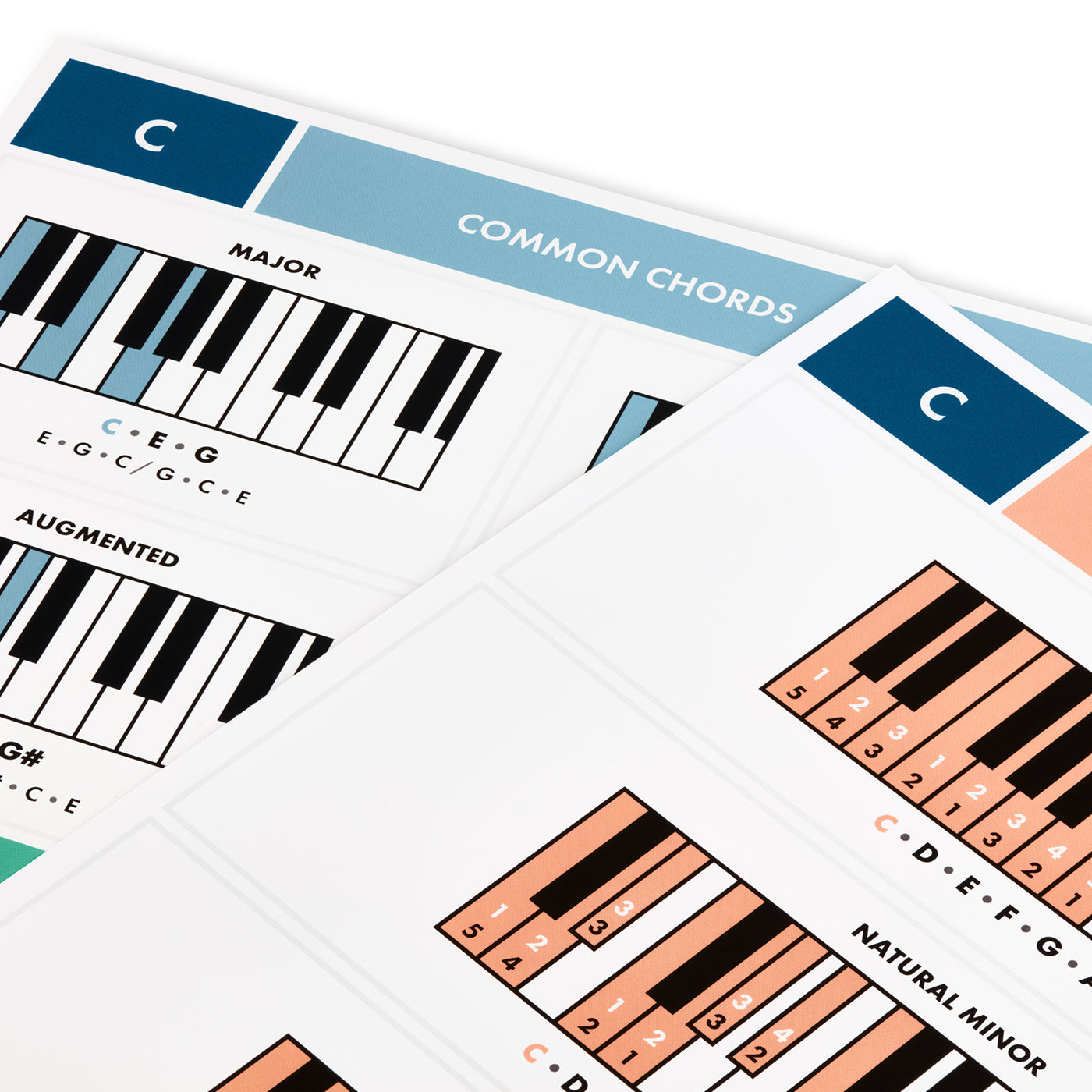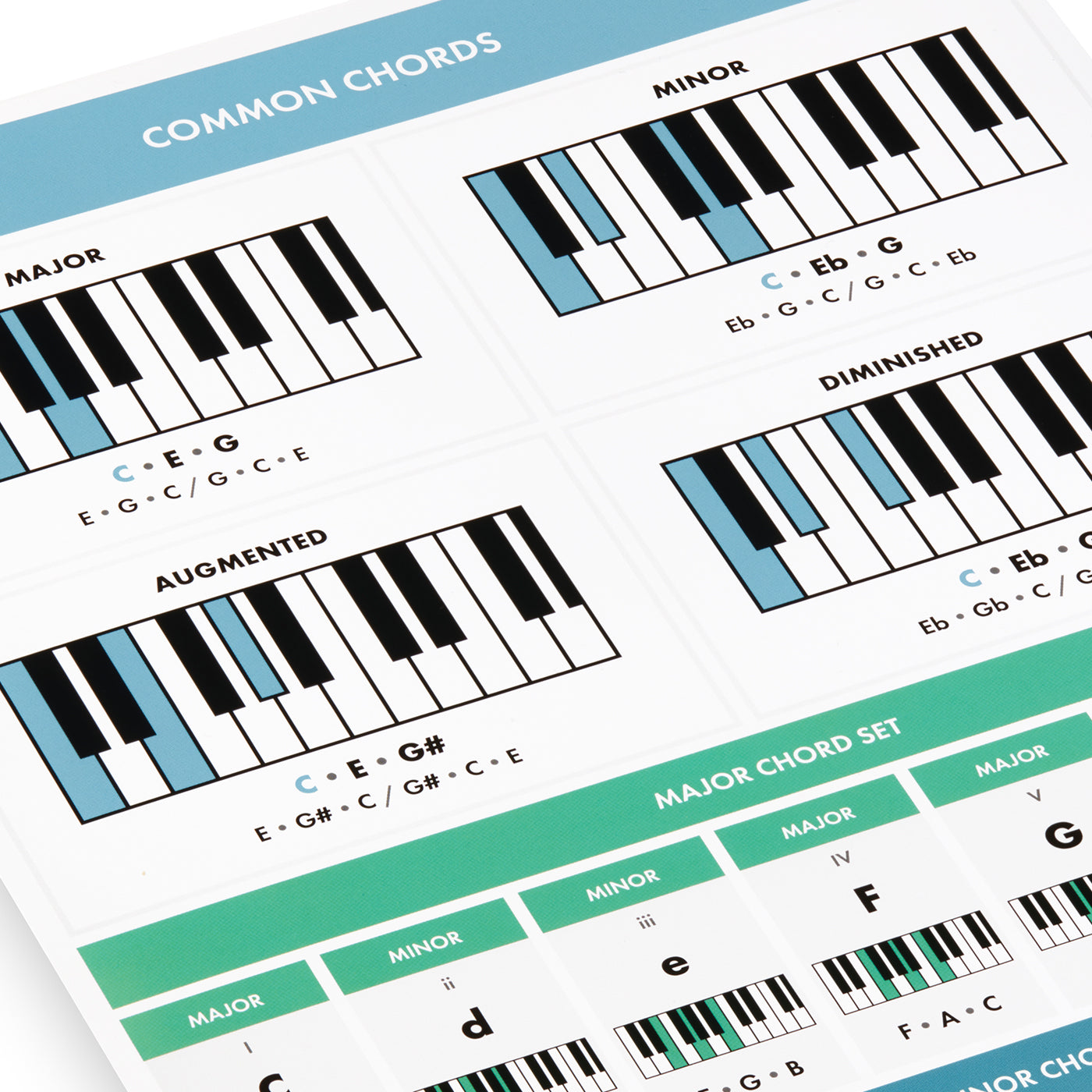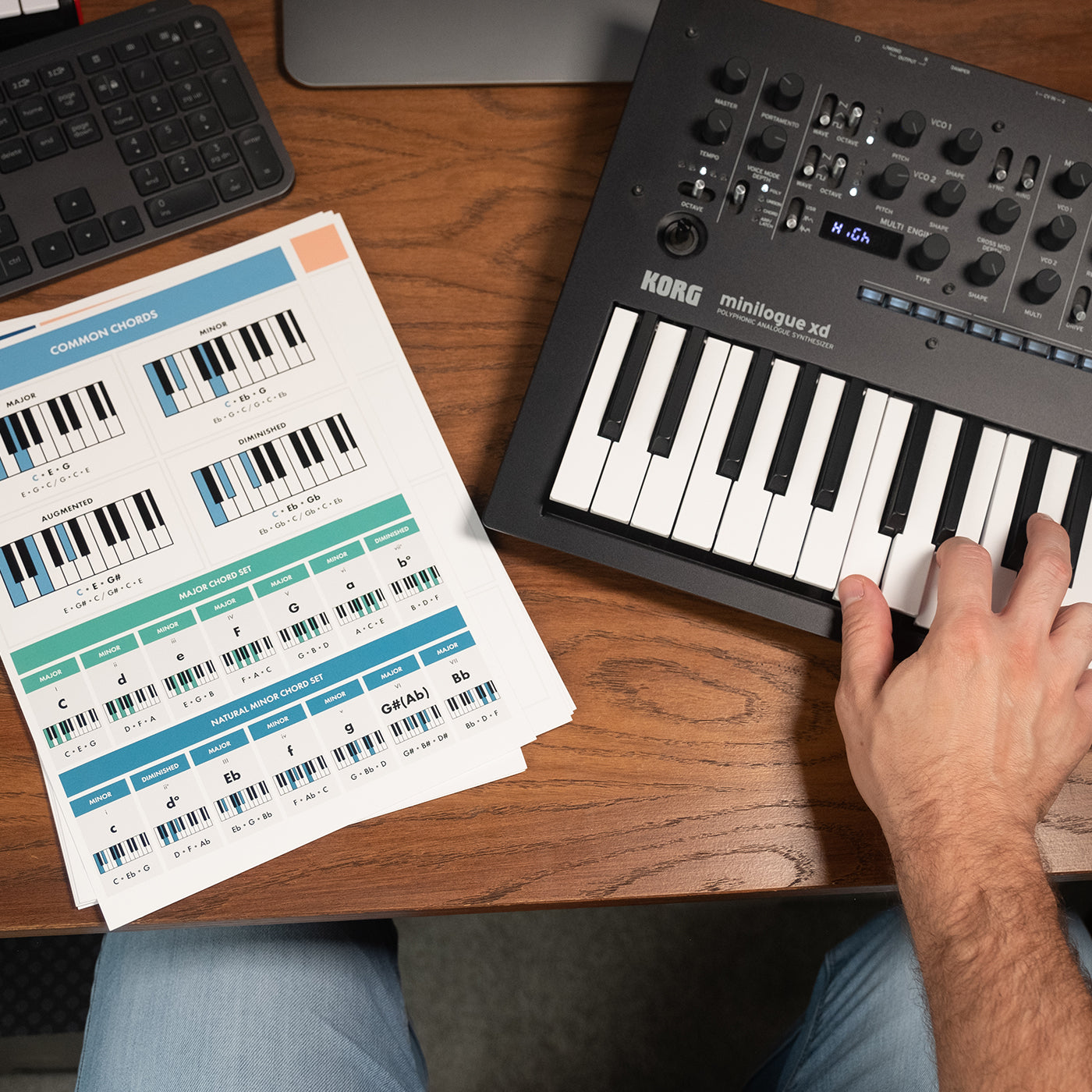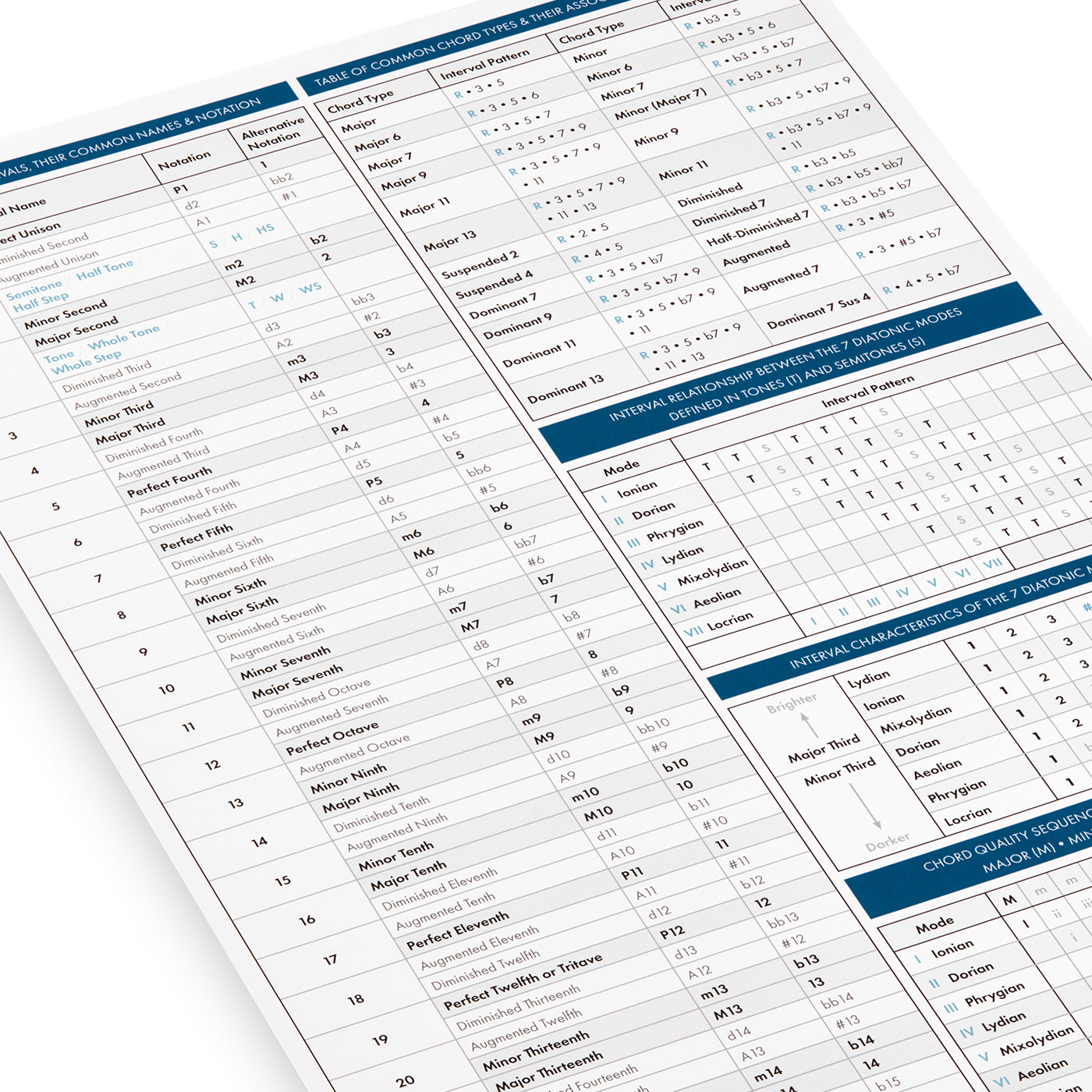When it comes to music, the best way to learn is by doing. Whether you’re having formal piano lessons or producing music in your own time, The Really Useful Piano Reference Cards contain all you need to become a better musician.
Each pack contains 12 A4-sized cards (plus a bonus music theory card) which include easy-to-read diagrams of scales, chords and chord progressions. The cards cover all the music theory you need to become a competent musician - including intervals, complex chords and modes.
Piano players and producers at any stage of their musical journey. Pianists can use these cards as they practise to advance their learning, and they’re packed with practical information to help music-makers bring their ideas to life. They make song writing quicker and easier and explain the theory behind the creative process. Whether you’re making music on a piano, a keyboard or a computer, you’ll learn by doing with these illustrated cards.
Pianists can use the cards to practise scales and chords until they’re committed to muscle memory. Each scale diagram comes with suggested fingerings which teach you the ‘right’ way to play them. The Really Useful Piano Reference Cards are fully illustrated, so it doesn’t matter if you can’t read classical music notation. Whatever level you’re playing at, these cards will help you to get more out of your practice sessions.
If you’re a producer, these cards will make every step of the song-writing process easier. They’ll enable you to identify which scale your melody is in, so that you can start playing around with complementary chords and progressions. If you haven’t found your melody yet, then you can use the cards to kick-start your composition. When you know which chords and scales work well together then you can make music more intuitively. Before long you’ll be creating catchier hooks and laying down better beats.

The Really Useful Piano Reference Cards help producers and pianists of all levels to make better music. Covering everything from scales to chord progressions, these easy-to-use cards guide you through the fundamentals of music theory. By teaching you about the building blocks of music, they’ll fast-track your learning and make practice more fun.
In each pack, you’ll find 12 double-sided cards which cover the 12 key signatures. The cards contain visual chord and scale diagrams, which means there’s no sight-reading required. Each pack also comes with a bonus card, which includes additional information on chord progressions, intervals and modes.
From playing your first chords, to writing your next album - these cards encourage creators of all abilities to unlock their musical potential.They’ll teach you how to identify the scale of your melody and find the best chords for your piece. Practise with them consistently, and you’ll memorise those all-important chords and scales, and get a better understanding of music theory.

Okay. So your Really Useful Piano Reference Cards have just arrived in the post. You can’t wait to get started. You open the pack and...what next?
Whatever your musical goal is, we’ve got you covered.
The Really Useful Piano Reference Cards help piano players to commit chords and scales to muscle memory. They’ll teach you the correct hand positions and fingering for each scale, so that you learn the best way to play them. With these cards, there’s no need for apps – which means you can stay in the zone as you play.
Pick one scale each day and practise it for 15 minutes - 5 minutes with your right hand, 5 minutes with your left hand, then 5 minutes with both hands together. Work through the major scales first, and then move on to the minor scales. Rinse and repeat until you can play every scale by heart! You’ll notice significant improvement after you’ve practised each scale five times over - which would take approximately four months if you’re working on one scale per day.
Producers can use The Really Useful Piano Reference Cards to help them find their creative flow. They enable music makers to discover which scale they’re playing in and identify the best chords to jam with. They’ll teach you which notes fit together, so that you can become a more intuitive songwriter. Over time you’ll start to absorb the music theory behind your songs by osmosis.
Choose a chord set and play all 7 chords in sequence. Once you can do that with ease, start playing the chords in a random order. This will help you to come up with your own unique progression. As soon as you’ve created something that you like the sound of, turn the card over to find the matching scale. You can then use the 7 notes in the scale to write a melody over the top of your chord progression. Try to do this for a different chord set every day to improve your playing skills and consistently create new music!
Head to our Learning Portal to find videos and guides that will support you on your creative journey.

A chord is a collection of two or more notes that are played together at the same time. You can choose any notes you like to create a chord. But it’s worth learning the most common chord types, as they appear in many popular pieces of music.
Major, minor, augmented and diminished. Those 4 chord types have created the world’s most beautiful songs. Once you understand how they’re formed, you can play and improvise with the best of them.
Just as a drumbeat provides rhythm, chords give structure to a song. They’re also a great way to create emotion. Chords are built using combinations of intervals - which means the distance between one note and another. By using different interval patterns, you can create distinct moods. This is how chords and chord sequences add suspense, sorrow or joy to a piece.
When you become familiar with each chord type, you can pick the perfect chords for any arrangement.
The Really Useful Piano Reference Cards contain visual diagrams of the 4 most common chords in every key signature - and their inversions. The chords are displayed in a large, easy-to-read format, with their notes written underneath them. This means you can instantly access all the notes you need, rather than having to figure out how to build each chord manually. Use these cards every time you practise, and you’ll soon be playing chords with ease.

A scale is a collection of notes, played in a particular order. Scales can start on any note and each has its own distinct sound.
Scales provide useful sets of notes, which sound good when played together. When you know which notes are in each scale, then it’s easier to riff and create new music.
Mastering your scales is a bit like learning how to touch-type. By practising them frequently you’ll improve your coordination and fluency. Once you’ve nailed your scales, you’ll be able to play with confidence. The more you practise them, the quicker you’ll commit them to memory!
The Really Useful Piano Reference Cards teach you about 4 of the most common scales: major, natural minor, harmonic minor and melodic minor. Each card is illustrated, which means that there’s no sight-reading necessary. The cards also give you a step-by-step guide on how to play each scale, with clearly indicated fingering for both the left and right hand.

A chord progression is made up of multiple chords played in succession. Much like individual chords, chord progressions create a sense of atmosphere. They work alongside the melody of a song to give it structure.
Each major and minor scale has its own set of 7 triad chords. All of these chords work well when played together because they’re made up of notes from the same scale. By memorising these chord sets you’ll become a more intuitive player and songwriter. Over time, they’ll help you to pick up music by ear and create more interesting compositions.
The Really Useful Piano Reference Cards cover the major and natural minor chord sets for each key signature. The chord sets are laid out in an accessible, visual format - so you don’t have to take the time to work them out yourself. Just refer back to your cards and you’ll be able to jam chord progressions in any key.

Music theory is the study of the rules and concepts that underpin every piece of music. It covers a huge range of topics, including scales, modes, musical terminology, harmonies, notation and much more.
You don’t have to study music theory in order to make and play music - but it definitely helps. If you can get to grips with the fundamentals, then you’ll be able to understand the instinctive choices you make when you play. The more you learn, the more informed your decisions will be. Think of music theory as a tool that can improve your performance and speed up the song writing process.
Each pack of The Really Useful Piano Reference Cards comes with a free bonus theory card. This card includes information on notation, intervals, extended chords and modes. Work through the card to learn new musical lingo and add complexity to your compositions.
With each purchase you’ll also immediately receive a free digital download of our original product - The Really Useful Piano Poster. So you can get practising straight away!
Free 2-day shipping to the UK and US
Worldwide shipping is charged at £15
Free digital download with this product
This product ships in an envelope
Each pack weighs approximately 250g / 0.55lb
Each card measures 210 x 297mm / 8.27 x 11.69in
We offset our carbon footprint via Ecologi
We use 100% recyclable paper and packaging
